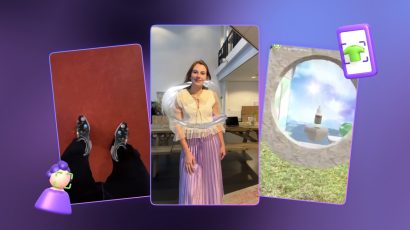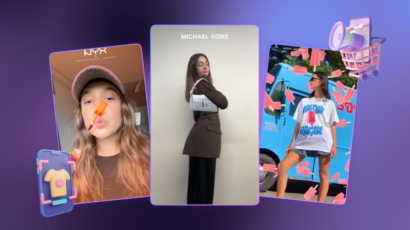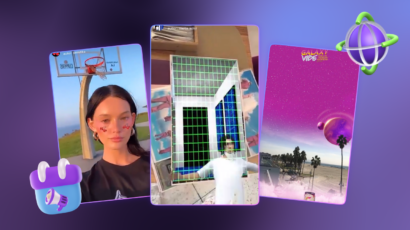Are you seeing no progress with your marketing strategies? It’s time to uncover the unparalleled power of AR.
Remaining relevant in the quick-paced world of marketing is a constant struggle. The dynamic digital environment necessitates creative solutions, and Augmented Reality (AR) has emerged as one such solution that has the power to revolutionize the industry.
Imagine being able to transform a static commercial into a captivating, interactive experience that engages the audience.
In this blog post, we’ll travel from the disappointment of conventional marketing to the thrill of being an early adopter of AR.
The AR Revolution: Breaking Through the Noise
If you’re a dissatisfied marketer, you’ve probably wondered if your campaigns are truly effective. Here comes AR, a cutting-edge approach that surpasses the constraints of conventional techniques. However, how does AR differ, and why is it creating such a stir in the marketing industry?
In a way that traditional approaches frequently fail to do, AR’s ability to produce captivating and amusing ads is one of the main reasons it has gained popularity.
AR the market size is the simplest metric to begin with. According to Fortune Business Insights, the size of the worldwide AR market was estimated at USD 42.20 billion in 2022 and is expected to increase at a compound annual growth rate (CAGR) of 50.7% from USD 62.75 billion in 2023 to USD 1,109.71 billion by 2030.
Engagement Redefined: Why Augmented Reality Goes Beyond a Buzzword
Given that consumers’ attention spans are getting shorter by the day, traditional marketing finds it difficult to compete. Here’s where AR comes in, providing an interactive method that engages viewers like never before. However, how might AR reinvent interaction, and what makes it so important for today’s marketers?
Augmented Reality transcends the two-dimensional boundaries of digital and print media. Customers can now engage with businesses and goods in ways that were previously unthinkable. Envision your target audience actively engaging with your marketing message rather than just watching it. Establishing a relationship is more important than merely getting someone’s attention.
Let’s have a closer look at the successful AR marketing campaigns.
Asos’ AR Triumph: Engaging Audiences and Boosting Confidence with the Virtual Catwalk
While the convenience of purchasing from home is undoubtedly a benefit of Internet shopping, it may also be a drawback because it prevents us from physically trying on clothing. To address this flaw, Asos unveiled their AR experience in 2019. A “live model” might be viewed by customers by touching the “AR” button next to a product to see the clothing on. This example shows how AR marketing can boost consumer confidence by providing customers with a genuine glimpse of how the product would actually look in real life. More information on the product is available to customers before purchase, which lowers return rates and benefits suppliers alike.
Adidas’ AR Innovation: Engaging Users and Reducing Returns with AR
Adidas has developed an AR app called “Sneakers try-on app,” which brings a whole new level to the world of shoe purchasing. Without ever leaving the main door, customers may virtually try on a variety of Adidas’ most recognizable models by using their smartphones. With the use of foot tracking software, users can preview how the shoes would appear on their own feet and choose the proper size by following their motions in real-time. Adidas’ innovative approach to footwear design set the standard for future AR trends, attracting customers and reducing return rates while raising conversion rates.
Tips for Marketers: Your Roadmap to AR Success
Take into consideration the following helpful tips to guarantee the smooth integration of AR into your marketing initiatives. Firstly, it is crucial to have a thorough understanding of your audience. Make sure your augmented reality experiences correspond with the tastes and habits of your intended audience. Your audience will connect with more relevant and captivating augmented reality content created with this tailored approach. Furthermore, consider AR as a storytelling medium rather than just a visual aid. Write engrossing stories that will leave a lasting impression on your audience by demonstrating your brand and striking an emotional chord.
Moreover, integration is essential. Integrate AR into your marketing strategy in a way that complements other media to create a unified and improved brand experience. The intention is not for AR to stand alone; rather, it should work in concert with your current processes to maximize their impact.
Finally, make use of user-generated content’s potential. Invite people who are interested in your brand to make and share augmented reality experiences. By doing this, you may reach a wider audience and build a genuine relationship with them, empowering them to become active participants in your brand’s story rather than just passive consumers.
Wrapping up: Embrace the Trend, Lead the Way, Make an Impact
Those who remain ahead of the curve become pioneers as the marketing landscape changes. Not just a passing fad, AR is a game-changing technology that has shown its value in a variety of sectors.
It’s time to embrace the thrill of being an AR pioneer and let go of the aggravation that comes with using conventional approaches. Instead of just following trends, start your own. Make a lasting impression on your audience and shape the direction your brand takes. The journey from frustration to fascination begins with exploration.
Set out on your AR adventure right away, and watch as your marketing tactics go above the norm. Lead the way, exert influence, and help mold the direction of AR marketing in the future. Now is the perfect moment to investigate your options and launch an AR-powered marketing revolution! Don’t hesitate to schedule a consultation with us to get more insights. From ideation to creation, let Crosscreators lead your AR way.







